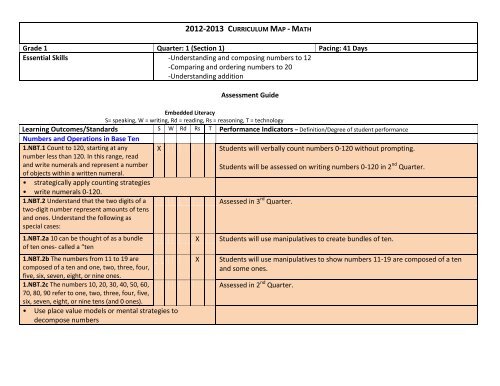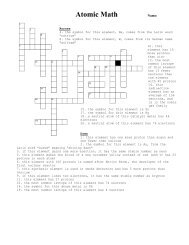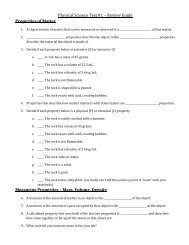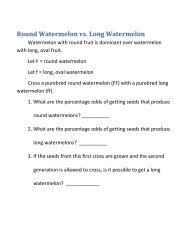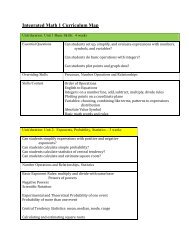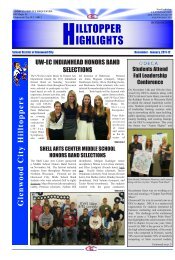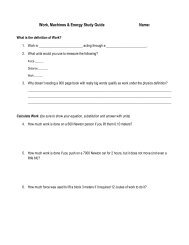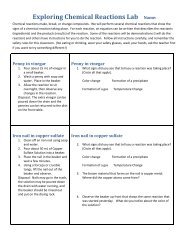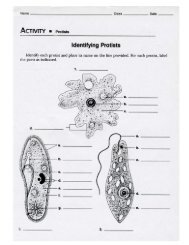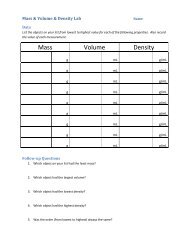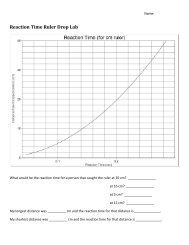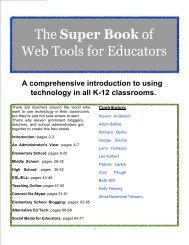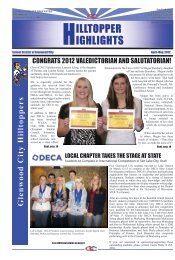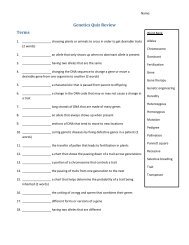Grade 1 Math
Grade 1 Math
Grade 1 Math
You also want an ePaper? Increase the reach of your titles
YUMPU automatically turns print PDFs into web optimized ePapers that Google loves.
Learning Outcomes/Standards S W Rd Rs T Performance Indicators – Definition/Degree of student performanceGeometry1.G.1 Distinguish between definingattributes (e.g., triangles are closed andthree-sided) versus non-defining attributes(e.g., color, orientation, overall size); buildand draw shapes to possess definingattributes.X X Students will be given a description verbally of shape attributes to draw thecorrect shapes. (circle, square, rectangle, triangle, and rhombus) Must get 5/5correct.Use defining characteristics to build/draw and identifybasic shapes1.G.2 Compose two-dimensional shapes(rectangles, squares, trapezoids, triangles,half-circles, and quarter-circles) or threedimensionalshapes (cubes, right rectangularprisms, right circular cones, and right circularcylinders) to create a composite shape, andX Xcompose new shapes from the compositeshape.• trapezoid• right rectangular prism• right circular cone• right circular cylinder• composite shapeStudents will use pattern blocks to compose two-dimensional shapes on a writtenassessment. Students will draw 4/4 of the shapes to get 100%.1. Students do not need to learn formalnames such as “right rectangular prism”Use shapes manipulative to create composite shapes3D will be assessed in 3 rd Quarter.
Learning Outcomes/Standards S W Rd Rs T Performance Indicators – Definition/Degree of student performanceOperations and Algebraic Thinking1.OA.5 Relate counting to addition andsubtraction (e.g., by counting on 2 to add 2).X• effectively communicate justifications for sums and differencesby relating the symbolic problems (equations) to appropriatemodels.1.OA.6 Add and subtract within 20,Xdemonstrating fluency for addition andsubtraction within 10. Use strategies such ascounting on; making ten (e.g.,8+6=8+2+4=10+4=14); decomposing anumber leading to a ten (e.g, 13-4=13-3-1=10-1=9; using the relationship betweenaddition and subtraction (e.g, knowing that8+4=12, one knows 12-8=4); and creatingequivalent but easier or known sums (e.g.,adding 6+7 by creating the known equivalent6+6+1=12+1=13).• use addition and subtraction thinking strategies efficiently basedon the values in the problem1.OA.7 Understand the meaning of the equal Xsign, and determine if equations involvingaddition and subtraction are true or false.For example, which of the followingequations are true and which are false? 6=6,7=8-1, 5+2=2+5, 4+1=5+2• partition equal groups of numbers in different ways• Efficiently apply strategies for determining the value of simpleaddition and subtraction mathematical phrases• use strategies for comparing quantities less than 20, (includingusing rational thinking to show equality or inequality ofmathematical phrases)1.OA.8 Determine the unknown wholenumber in an addition or subtractionequation relating three whole numbers. Forexample, determine the unknown numberStudents will complete <strong>Math</strong> Expressions Unit 2, Quick Quizzes 3 and 4, to relatecounting to addition and subtraction. Students will get at least 8/10.Students will correctly answer 52/64 addition problems and 52/64 subtractionproblems on a written assessment within 5 minutes for each one.When given a written assessment, students will circle number sentences that aretrue (assessment includes both addition and subtraction). Students will get atleast 8/10.• equationStudents will complete <strong>Math</strong> Expressions Unit 3, Quick Quiz 4, to determine theunknown whole number in addition and subtraction equations with threenumbers. Students will get at least 5/6.
that makes the equation true in each of theequations 8+?=11, 5=__-3, 6+6=__.• efficiently apply strategies for solving simple equations with oneunknown• justify solutions for single unknown equations• equation
2012-2013 CURRICULUM MAP - MATH<strong>Grade</strong> 1 Quarter: 4 (Section 4) Pacing: 54 daysEssential Skills-Using addition and subtraction strategies-Using and interpreting data-Using fractions to describe equal parts-Measuring and comparing lengths-Adding and subtracting tens and onesAssessment GuideEmbedded LiteracyS= speaking, W = writing, Rd = reading, Rs = reasoning, T = technologyLearning Outcomes/Standards S W Rd Rs T Performance Indicators – Definition/Degree of student performanceGeometry1.G.3 Partition circles and rectangles intotwo and our equal shares, describe theshares using the words halves, fourths, andquarters, and use the phrases half of, fourthof, and quarter of. Describe the whole astwo or, or four of the shares. Understand forthese examples that decomposing into moreequal shares creates smaller shares.decompose circles and rectangles into halves and fourthscommunicate the size of pieces using the appropriatefraction terminologycommunicate the relative size of halves and fourths byreasoning bout the number of shares createdX X Students will show understanding of the terms half, fourth, two shares, or quarterusing a written assessment verbally explained by the teacher with 100% accuracy.Learning Outcomes/Standards S W Rd Rs T Performance Indicators – Definition/Degree of student performanceMeasurement and Data1.MD.1 Order three objects by length;compare the lengths of two objectsindirectly by using a third object.X X When given three objects, students will order them by length and verballydescribe each object compared to the other ones.
• use direct and indirect comparison to order objects bylength1.MD.2 Express the length of an object as a Xwhole number of length units, by layingmultiple copies of a shorter object (thelength unit) end to end; understand that thelength measurement of an object is thenumber of same-size length units that spanit with no gaps or overlaps. Limit to contextswhen the object being measured is spannedby a whole number of length units with nogaps or overlaps.• accurately measure length using non-standard units (tothe nearest whole unit)1.MD.4 Organize, represent, and interpret Xdata with up to three categories; ask andanswer questions about the total number ofdata points, how many in each category, andhow many more or less are in one categorythan in another.choose and apply appropriate strategies for organizingand recording dataread and interpret graphical representations (physicalgraphs, tally charts, pictographs, and bar graphs) of datacommunicate and defend solutions and solution pathsWhen given a written assessment with 5 objects to measure, students willaccurately measure 4/5 objects to the nearest whole number using unifix cubes.Students will complete <strong>Math</strong> Expressions, Unit 6 Quick Quiz 1, to showunderstanding of picture graphs and will get at least 4/5.Students will complete a written assessment with 100% accuracy to demonstrateunderstanding of a bar graph.Learning Outcomes/Standards S W Rd Rs T Performance Indicators – Definition/Degree of student performanceNumbers and Operations in Base Ten1.NBT.4 Add within 100, including adding atwo-digit number and a one-digit number,and adding a two-digit number and amultiple of 10, using concrete models ordrawings and strategies based on placevalue, properties of operations, and/or therelationship between addition andsubtraction; relate the strategy to a writtenXStudents will demonstrate understanding using <strong>Math</strong> Expressions, Unit 8 QuickQuiz 2 and will get at least 4/5.
method and explain the reasoning used.Understand that in adding two-digitnumbers, one adds tens and tens, ones andones; and sometimes it is necessary tocompose a ten.• model addition problems using appropriate tools• record strategies for solving addition problems• communicate the relationship between models andsymbolic (numeric) representations of solutions toaddition problems1.NBT.5 Given a two-digit number, mentallyfind 10 more or 10 less than the number,without having to count; explain thereasoning used.• use patterns and regularity in counting sequences andunderstandings of place value to add or subtract a “ten”• communicate reasoning and solution strategies1.NBT.6 Subtract multiples of 10 in the range10-90 from multiples of 10 in the range 10-90 (positive or zero differences), usingconcrete models or drawings and strategiesbased on place value, properties ofoperations, and/or the relationship betweenaddition and subtraction; relate the strategyto a written method and explain thereasoning used.• multiple of 10X X Students will verbally answer 10 more or 10 less than a number given by theteacher and explain their reasoning.X X Students will subtract multiples of ten from a multiple of ten and explain thereasoning used. Students will accurately answer 8/10.• multipleLearning Outcomes/Standards S W Rd Rs T Performance Indicators – Definition/Degree of student performanceOperations and Algebraic Thinking1.OA.1 Use addition subtraction within 20 tosolve word problems involving situations ofadding to, taking from, putting together,taking apart, and comparing, with unknownsin all positions, e.g., by using objects,drawings, and equations with a symbol forthe unknown number to represent theproblemX Students will complete <strong>Math</strong> Expressions Unit 9, Quick Quiz 1, and get 4/4.
• represent quantities and operations (addition & subtraction)physically, pictorially, or symbolically• strategically use a variety of representations to solve additionand subtraction word problems• use informal and mathematical language to communicate theconnections among addition and subtraction contexts andrelate physical, pictorial, or symbolic representations.• accurately compute sums and differences• use symbols to represent unknown quantities in equations1.OA.2 Solve word problems that call foraddition of three whole numbers e.g., byusing objects, drawings, and equations witha symbol for the unknown number torepresent the problem.• efficiently apply strategies for solving multiple addendproblems• use symbols to represent unknown quantities in equations• accurately compute sums1.OA.3 Apply properties of operations asstrategies to add and subtract. 2 Examples: If8+3=11 is known, then 3+8=11 is alsoknown. (Communitive property of addition.)To add 2+6+4, then second two numbers canbe added to make a ten, so 2+6+4=2+10=12,(Associative property of addition.)X X Students will read and solve 4/5 story problems that include 3 numbers using awritten assessment.Students will demonstrate the ability to apply these properties by completing awritten assessment. (NEED TO CREATE)2 Students need not use formal terms forthese properties.• strategically and efficiently apply properties of addition inorder to find sums• communitive property of addition• associative property of addition1.OA.4 Understand subtraction as anunknown-addend problem.For example, subtract 10-8 by finding thenumber that makes 10 when added to 8.Add and subtract within 20.• use symbols such as blanks, boxes, or letters to representunknown quantities in equations• use mathematical language to communicate the connectionsStudents will demonstrate understanding of a subtraction problem as an unknownaddend problem by completing a written assessment. (NEED TO CREATE)• addend
etween an unknown difference problem and the relatedunknown addend problem• use the inverse relationship between addition and subtractionto find differences• choose and apply addition and subtraction strategies toaccurately determine sums and differences within 20.


